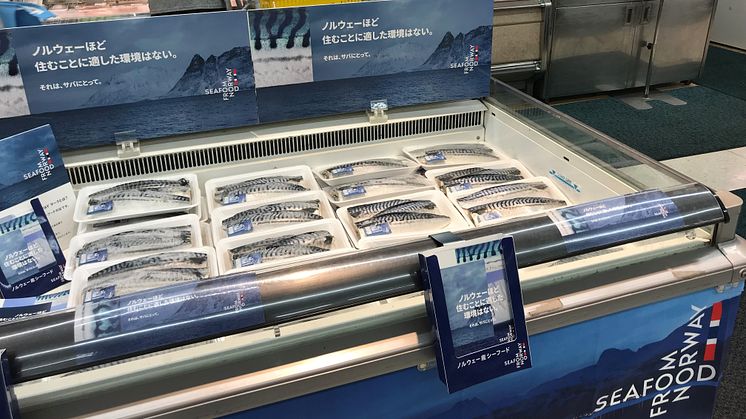
Press release -
March all-time-high boosts a solid first quarter for Norwegian seafood exports
Never before has the value of Norwegian seafood exports been higher in March than in 2021. In the first three months of the year, Norway exported seafood worth NOK 27.7 billion, a decrease in value of 3 per cent, or NOK 742 million, compared with the same period last year. It is still the second-best first-quarter result ever.
"Norwegian seafood exports have had a solid start in 2021, primarily due to a substantial increase in export value in March, especially for salmon. Thanks to a record high volume, salmon exports in March are the highest recorded in a single month", says Renate Larsen, the Norwegian Seafood Council's CEO.
Record-breaking March
There was a decline in export value in both January and February, but this reversed in March. Historically, it is only in October 2019 that the export value has been higher in a single month.
- In March, seafood worth NOK 10.9 billion was exported
- This represents an increase in value of 13.5 per cent, or NOK 1.3 billion, compared with March last year.
Even though the corona pandemic continues to affect the seafood markets, it is gratifying that Norwegian seafood's export value has never seen a more vital March than this year. Our seafood is sought after all over the world. Behind the numbers is an adaptable industry with good people at all levels", says Odd Emil Ingebrigtsen (H), Minister of Fisheries and Seafood.
Challenges
"2021 has given us the second-best result in history for seafood exports in the first quarter. Nevertheless, we must acknowledge that there are still challenging times for parts of the industry. This especially applies to cod products, such as fresh cod and clipfish", says Renate Larsen.
Strengthened Norwegian kroner
She also points out that a weak Norwegian krone helped to keep the export value up in 2020. Seafood exports have not benefitted from that support this year.
"Although Norwegian seafood has become more expensive for buyers, there have been large volumes and relatively strong demand for salmon, herring, and king crab products in the first quarter", says Renate Larsen.
Record high salmon volume
- Norway exported 297,200 tonnes of salmon for NOK 18 billion in the first quarter.
- The volume increased by 18 per cent compared with the first quarter last year.
- The value fell by NOK 704 million, or 4 per cent, compared with the first quarter last year.
- The average price for fresh whole salmon fell from NOK 69 per kg to NOK 54.43 per kg.
- Poland, France and the USA were the largest recipients of salmon from Norway in the first quarter.
"The value of salmon exports in March was the highest recorded in a single month, which is primarily due to a record high volume. Although the Norwegian krone has strengthened against the euro and US dollar, the average price in March was only one percent lower than in the same period last year", says Paul T. Aandahl, Seafood Analyst with the Norwegian Seafood Council.
Asia is growing the most
Although there is growth in the most critical markets, salmon exports to Asia are increasing the most.
"This is related to a gradual normalization of demand, at the same time as competition from other salmon-producing nations seems to have been reduced, says Paul T. Aandahl.
Salmon exports were in March were as follows:
- 108,200 tonnes of salmon worth NOK 7.2 billion were exported.
- There is an increase in the volume of 28 per cent.
- The value increased by NOK 1.3 billion, or 22 per cent, compared with March last year.
Trout exports decline
- Norway exported NOK 12,100 tonnes of trout for NOK 751 million in the first quarter.
- The volume fell by 22 per cent.
- The value fell by NOK 216 million, or 22 per cent, compared with the first quarter last year.
- The average price for fresh whole trout was NOK 58.54. This is NOK 4 higher than the average price for fresh whole salmon.
- The USA, Belarus and Japan were the largest markets for Norwegian trout in the first quarter.
"After a strong record export of trout last year, the volume falls in 2021. This has resulted in a higher price for trout than salmon in the first quarter of 2021 and led to some markets such as Ukraine, Malaysia and Indonesia replacing trout with salmon, says Paul T. Aandahl, Marine Analyst with the Norwegian Seafood Council.
As in the first quarter, there was also a reduction in the value of trout in March:
- 4,500 tonnes of trout were exported worth NOK 300 million.
- The volume fell by 11 per cent.
- The value fell by NOK 15 million, or 5 per cent, compared with March last year.
Downturn for cod exports
- Norway exported 29,200 tonnes of fresh cod worth NOK 1.1 billion in the first quarter.
- There is an increase in the volume of 27 per cent.
- The value is at the same level as the first quarter last year. Of this, 3,900 tonnes of quality-marked cod were exported worth NOK 165 million
- The volume fell by 17 per cent.
- The value fell by NOK 64 million, or 28 per cent in the first quarter.
- Denmark, Poland and the Netherlands were the largest recipients of fresh cod from Norway in the first quarter.
The most significant volume increases for fresh cod were in Portugal and Poland, increasing their volumes by more than 1,300 tonnes, or 640 and 68 per cent, respectively.
"Export prices for fresh cod have fallen in line with landing prices in the first quarter. This has affected the cod, which is experiencing a decline in both volume and value compared with the first quarter of last year", says Eivind Hestvik Brækkan, Seafood Analyst with the Norwegian Seafood Council.
Concerning the development of fresh cod in March, export figures show a significant increase in both value and volume:
- 14,300 tonnes of fresh cod were exported worth NOK 490 million.
- There is an increase in the volume of 76 per cent.
- The value increased by NOK 131 million, or 37 per cent, compared with March last year.
Increased exports of frozen cod to Europe
- Norway exported 25,400 tonnes of frozen cod worth NOK 975 million in the first quarter.
- There is an increase in the volume of 10 per cent.
- The value fell by NOK 92 million, or 9 per cent, compared with the first quarter last year.
- China, the United Kingdom and Lithuania were the largest recipients of frozen cod in the first quarter.
There is still a shift towards more frozen cod being exported to Europe at the expense of Asia. As much as 67 per cent of the frozen cod went to Europe, compared with 60 per cent in the first quarter last year.
All-time high in value terms
"Exports of frozen cod from Norway to the UK do not appear to be affected by Brexit. Exports of frozen cod to the United Kingdom and France increased by more than 500 tonnes in the first quarter of 2021. This corresponds to an increase of 37 and 21 per cent, respectively", says Eivind Hestvik Brækkan, Marine Analyst with the Norwegian Seafood Council.
In March, the export value of frozen cod further strengthened growth, and in March, value was the highest ever in a single month:
- 11,900 tonnes of frozen cod were exported worth NOK 464 million.
- There is an increase in the volume of 22 per cent.
- The value increased by NOK 12 million, or 3 per cent, compared with March last year.
Historical change for clipfish
- Norway exported 23,000 tonnes of clipfish worth NOK 996 million in the first quarter.
- There is an increase in the volume of 4 per cent.
- The value fell by NOK 162 million, or 14 per cent, compared with the first quarter last year.
- Brazil, Portugal and the Dominican Republic were the most important markets for Norwegian clipfish in the first quarter.
"For the first time in a quarter, the export value of saithe clipfish is greater than cod clipfish. A decrease in volume and value for clipfish of cod contributes most to the decline in value overall, while clipfish of saithe has increased both in value and volume", says Eivind Hestvik Brækkan, Marine Analyst with the Norwegian Seafood Council.
In March, the export value of Norwegian clipfish fell, both in euros and Norwegian kroner, compared with March last year:
- 6,700 tonnes of clipfish were exported worth NOK 301 million.
- There is an increase of 9 per cent in volume.
- The value fell by NOK 70 million, or 19 per cent, compared with March last year.
Low salted fish prices
- Norway exported 5,500 tonnes of salted fish worth NOK 245 million in the first quarter.
- There is a decrease in volume of 33 per cent.
- The value fell by NOK 260 million, or 51 per cent, compared with the first quarter last year.
- Portugal, Greece and Spain were the most important markets for Norwegian salted fish in the first quarter.
"Export volume to Portugal fell as much as 2,000 tonnes, or 54 per cent, in the first quarter, and salted fish prices are still significantly lower than at the same time last year, says Eivind Hestvik Brækkan, Marine Analyst with the Norwegian Seafood Council.
This trend is also reflected in the figures for salted fish exports in March:
- 2,400 tonnes of salted fish were exported worth NOK 104 million.
- There is a decrease in volume of 52 per cent.
- The value fell by NOK 226 million, or 69 per cent, compared with March last year.
Stockfish growth in March
- Norway exported 1,100 tonnes of stockfish worth NOK 200 million in the first quarter.
- There is an increase in the volume of 6 per cent.
- The value fell by NOK 7 million, or 3 per cent, compared with the first quarter last year.
- Italy, Nigeria and the USA were our most important markets for stockfish in the first quarter.
"Stockfish exports to Italy were sharply reduced last year as a result of the corona pandemic, while the figures so far this year are back at 2019 levels. Following an estimated stock reduction last year, it appears that importers are now replenishing their stocks. However, closures of traditional stock channels for stockfish continue to put a damper on consumption, and we do not expect any major growth until the closures are lifted", says the Norwegian Seafood Council's seafood envoy to Italy Trym Eidem Gundersen.
In March, there was an increase in both value and volume for stockfish:
- 335 tonnes of stockfish were exported worth NOK 50 million.
- There is an increase in the volume of 65 per cent.
- The value increased by NOK 16 million, or 46 per cent, compared with March last year.
Strong start for herring
- Norway exported 121,000 tonnes of herring worth NOK 1.3 billion in the first quarter.
- This is an increase of NOK 212 million, or 19 per cent, compared with the first quarter last year.
- The volume increased by 15 per cent from 105,000 tonnes.
- Poland, Lithuania and Nigeria were the most important markets for Norwegian herring in the first quarter.
"It has been a solid start for the year for herring exports, and we must go back to 2012 to find a higher export value for herring in the first quarter. With an increase in the Norwegian spring-spawning herring (NVG) quota of 24 per cent, We expected prices to come under pressure, but this has not happened. Through the pandemic, herring has experienced increased demand in many markets, and the lack of large herring has contributed to pushing up prices, says Jan Eirik Johnsen, responsible for pelagic species with the Norwegian Seafood Council.
In March, there was a decrease in volume and an increase in value for herring:
- 28,900 tonnes of herring were exported worth NOK 407 million.
- There is a reduction in the volume of 10 per cent
- The value increased by NOK 30 million, or 8 per cent, compared with March last year.
New mackerel record
- Norway exported 89,700 tonnes of mackerel worth NOK 1.4 billion in the first quarter.
- There is an increase in the volume of 10 per cent.
- The value increased by NOK 20 million, or 1 per cent, compared with the first quarter last year.
- South Korea, Japan and China were the largest markets for Norwegian mackerel in the first quarter.
"Last year, mackerel set a new export record, and the trend continues in the first quarter with a new record. Like herring, mackerel has increased demand during the pandemic. In Asia, we see that demand for healthy and affordable products is a crucial explanation - in addition to good availability in grocery stores, says Jan Eirik Johnsen, responsible for pelagic species with the Norwegian Seafood Council.
Strong growth in Asia
Important consumer markets such as Japan, South Korea and Taiwan are all showing strong development.
"Overall, exports to these markets increased by 40 per cent in the first quarter compared with last year. The processing markets Vietnam and Indonesia are also growing sharply, with over 100 per cent growth in the period compared with last year", says Jan Eirik Johnsen.
In March, there was a decline in the volume and value of mackerel:
- 18,800 tonnes of mackerel worth NOK 296 million were exported.
- There is a reduction in volume of 9 percent.
- The value fell by NOK 64 million, or 18 per cent, compared with March last year.
Record high solder prices
- Norway exported 29,500 tonnes of capelin worth NOK 471 million in the first quarter.
- If we exclude direct landings in Iceland and the Faroe Islands, China, Japan and Vietnam were the largest capelin markets in the first quarter.
Last year, there was a robust export of herring roe, with a value of NOK 429 million due to a lack of capelin roe in the markets.
"This year, roe production was significantly lower, but the Norwegian fleet received a capelin quota in Icelandic waters for the first time in several years. The absence of capelin has created demand in several markets, which resulted in record-high prices in the first quarter", says Jan Eirik Johnsen, responsible for pelagic species with the Norwegian Seafood Council.
Record for king crab
- Norway exported 701 tonnes of king crab worth NOK 249 million in the first quarter.
- There is an increase in the volume of 68 per cent.
- The value increased by NOK 109 million, or 77 per cent, compared with the first quarter last year.
- South Korea, the Hong Kong SAR and the United States were the largest king crab recipients in the first quarter.
"For king crab, we have in 2021 seen our best first quarter ever. There is growth in the vast majority of markets. Still, especially Hong Kong, Korea, the USA and Vietnam increase both volume and value", says Ørjan Kjærvik Olsen, Shrimp and Shellfish Analyst with the Norwegian Seafood Council.
Strong March exports
The reason for the strong quarter is complex, but Olsen points to several factors:
- Higher quotas
- Larger landings
- Increase in the number of boats
- Good fishing
"Prices are supported by solid demand in the market, driven by, among other things, high prices for king crab in stores in the US and high activity in the restaurant market in parts of Asia", says Ørjan Kjærvik Olsen.
March also gave growth, both in value and volume:
- 172 tonnes of king crab were exported worth NOK 71 million.
- There is an increase in the volume of 157 per cent.
- The value increased by NOK 48 million, or 205 per cent, compared with March last year.
Decline for prawn
- 2,900 tonnes of prawn worth NOK 221 million were exported in the first quarter.
- The volume decrease was 5 per cent.
- The value fell by NOK 26 million, or 11 per cent, compared with the first quarter last year.
- The largest recipients were Sweden, the United Kingdom and Finland.
"Prawn exports to Denmark and the UK in the first quarter are declining, but a good March in the UK gives reason for cautious optimism. Another bright spot is growth in both volume and value in February and March in our largest market Sweden, compared with the same period last year", says Ørjan Kjærvik Olsen, Prawn and Shellfish Analyst with the Norwegian Seafood Council.
March saw a further drop in prawn exports:
- In March, 1,200 tonnes of prawn were exported worth NOK 89 million.
- There is a reduction in the volume of 11 per cent.
- The value fell by NOK 14 million, or 14 per cent, compared with March last year.
Topics
Categories
The Norwegian Seafood Council works with the Norwegian fisheries and aquaculture industries to develop markets for Norwegian seafood through local market intelligence, market development and reputational risk management. The Seafood Council is headquartered in Tromsø and maintains local representatives in twelve of Norway's most important international markets. The Norwegian seafood industry finances the activities of the Norwegian Seafood Council via a tariff on all Norwegian seafood exports.
The Norwegian Seafood Council is a public company owned by the Ministry of Trade, Industry and Fisheries.



